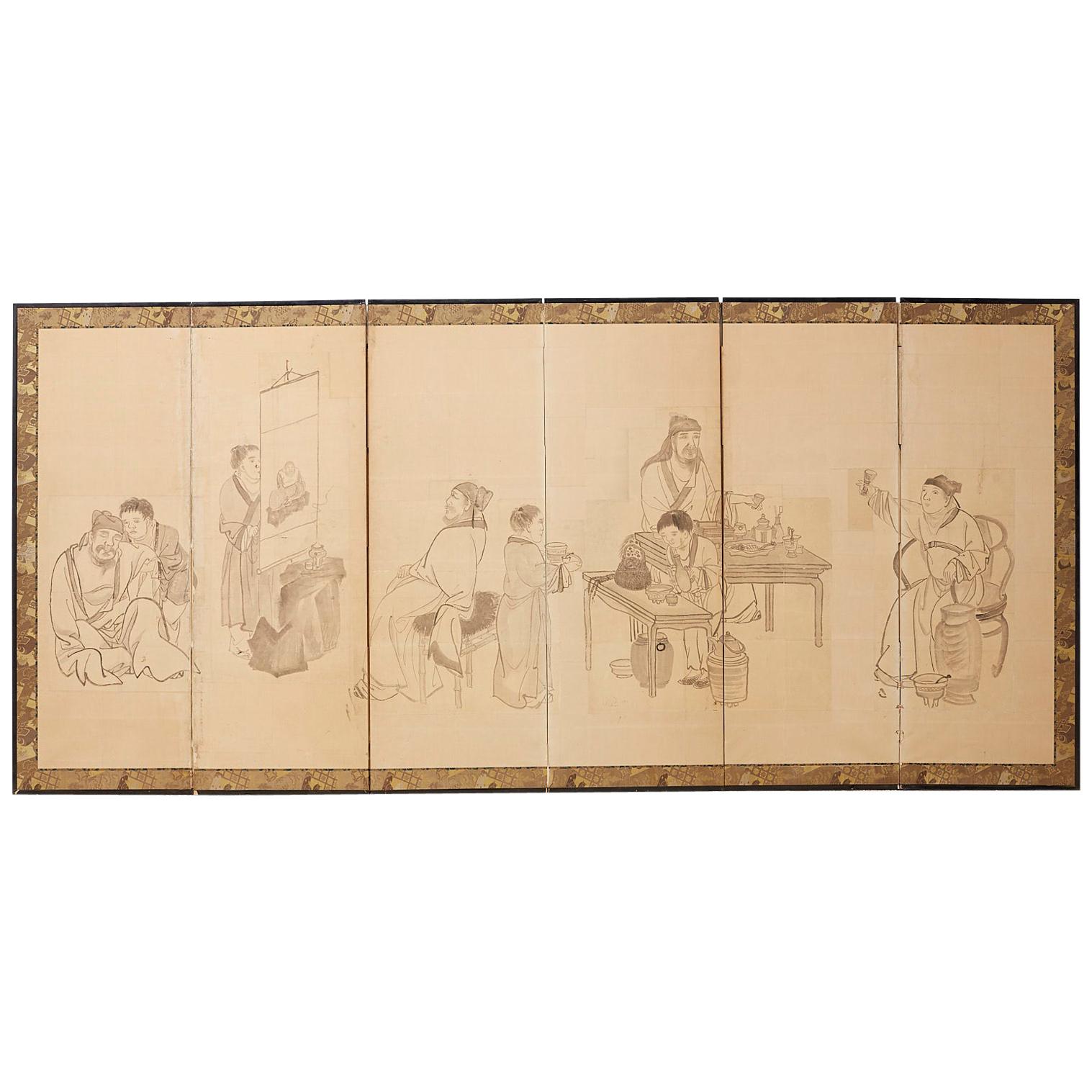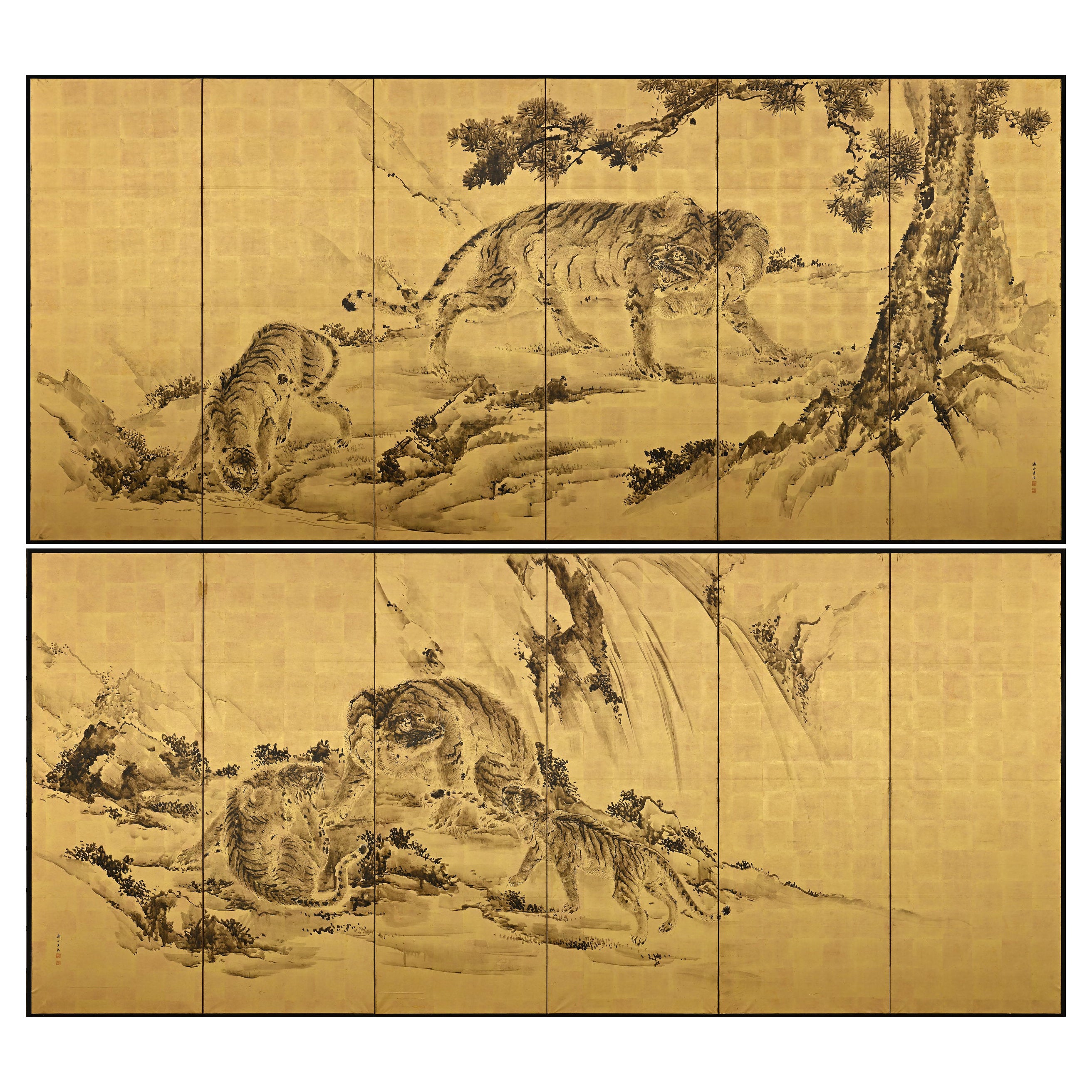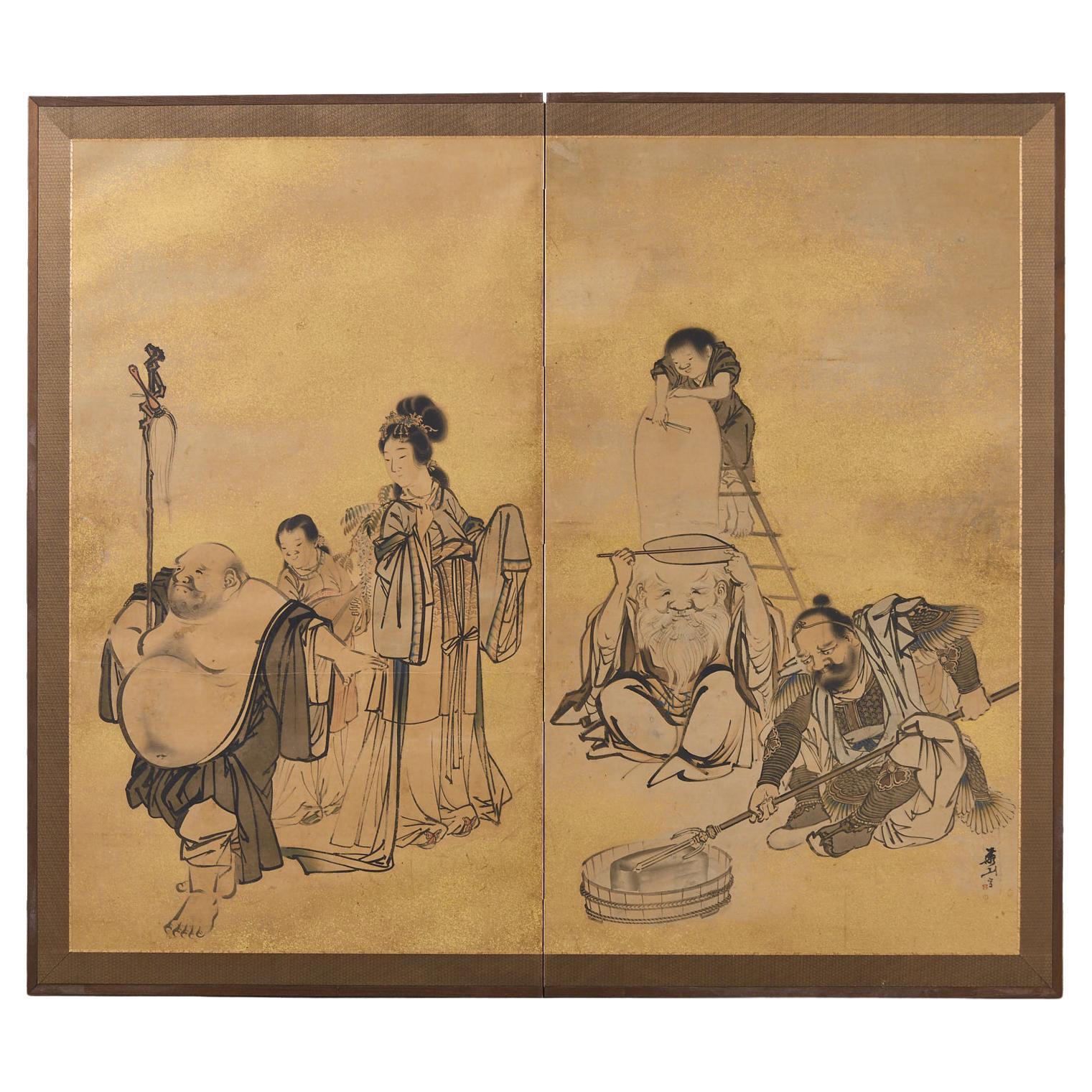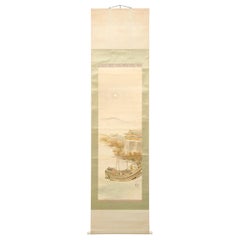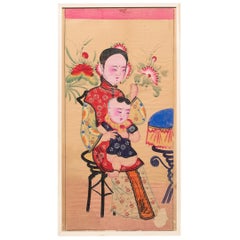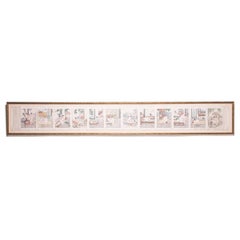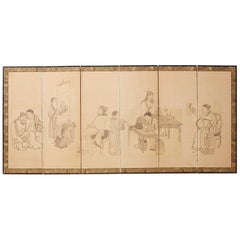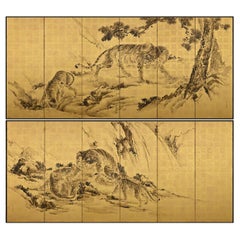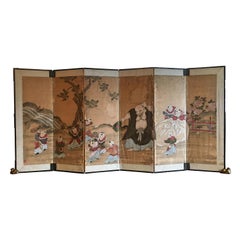Items Similar to Japanese Edo Period Festival Screen, c. 1750
Want more images or videos?
Request additional images or videos from the seller
1 of 12
Japanese Edo Period Festival Screen, c. 1750
About the Item
This 18th century folding screen is a stunning example of Japanese artistry. Beautifully painted with delicate brushwork, the evocative screen depicts a lively festival during the Edo period (1615–1912). The raucous scene is full of life; within the dense crowd, you can make out people dancing, playing instruments, riding horseback, and waving banners. Each of the eight panels is completely unique and painted with exquisite detail. Given the fragility of paper artworks, a screen of this age and quality is a rare and extremely rewarding discovery.
- Dimensions:Height: 23.75 in (60.33 cm)Width: 143.5 in (364.49 cm)Depth: 0.75 in (1.91 cm)
- Style:Edo (Of the Period)
- Materials and Techniques:
- Place of Origin:
- Period:
- Date of Manufacture:circa 1750
- Condition:Wear consistent with age and use.
- Seller Location:Chicago, IL
- Reference Number:Seller: SUP0011stDibs: LU820014571111
About the Seller
5.0
Platinum Seller
Premium sellers with a 4.7+ rating and 24-hour response times
Established in 1997
1stDibs seller since 2006
1,666 sales on 1stDibs
Typical response time: 1 hour
- ShippingRetrieving quote...Shipping from: Chicago, IL
- Return Policy
Authenticity Guarantee
In the unlikely event there’s an issue with an item’s authenticity, contact us within 1 year for a full refund. DetailsMoney-Back Guarantee
If your item is not as described, is damaged in transit, or does not arrive, contact us within 7 days for a full refund. Details24-Hour Cancellation
You have a 24-hour grace period in which to reconsider your purchase, with no questions asked.Vetted Professional Sellers
Our world-class sellers must adhere to strict standards for service and quality, maintaining the integrity of our listings.Price-Match Guarantee
If you find that a seller listed the same item for a lower price elsewhere, we’ll match it.Trusted Global Delivery
Our best-in-class carrier network provides specialized shipping options worldwide, including custom delivery.More From This Seller
View AllSet of Four Chinese Immortals Screen Paintings, c. 1850
Located in Chicago, IL
Since the 12th century people in China have used folding screens and doors to partition and decorate their homes—the vivid scenes backing the screens added life and color to a room. ...
Category
Antique Mid-19th Century Chinese Qing Paintings and Screens
Materials
Paper
Japanese Meiji Riverside Scroll Painting, c. 1900
Located in Chicago, IL
Although western painting was initially embraced during Japan’s Meiji period (1868-1912), artists brought on a revival of traditional painting styles as they sought to create a modern Japanese style with roots in the past. This exquisite hanging scroll demonstrates the preference for soft layering of gray tones with judicious use of color. The landscape is rendered in soft ink washes that subtly distinguish between water, mountain, and sky. The scroll painting...
Category
Early 20th Century Japanese Meiji Paintings and Screens
Materials
Paper
Chinese Yangliuqing New Year Painting of Beauty and Baby, c. 1920
Located in Chicago, IL
Chinese New Year paintings (nian hua) are colorful folk paintings created to celebrate the annual Spring Festival. Drawn or printed by folk artists in regional studios, nian hua pain...
Category
Vintage 1920s Chinese Folk Art Paintings and Screens
Materials
Paper
Framed Chinese Erotic Pillow Book, c. 1850
Located in Chicago, IL
A pillow book was meant to teach a young bride about the art of lovemaking. This rare museum-quality 19th century example is composed of 12 masterfully pai...
Category
Antique Mid-19th Century Chinese Qing Paintings and Screens
Materials
Silk, Paper
Chinese Erotic Album Leaf, c. 1850
Located in Chicago, IL
Despite its explicit content, this intimate scene conveys a sense of tenderness and romantic love characteristic of Chinese erotic art. Known as “sp...
Category
Antique Mid-19th Century Chinese Qing Paintings and Screens
Materials
Paper
"Literary Gathering" Chinese Scroll Painting, c. 1923
Located in Chicago, IL
Exquisitely painted with delicate line work and a subdued color palette, this Chinese scroll painting is an Late 20th-century reproduction of a...
Category
Late 20th Century Chinese Paintings and Screens
Materials
Silk, Paper
You May Also Like
Japanese Edo Period Six Panel Screen of Chinese Scholars
Located in Rio Vista, CA
Fascinating 19th century Japanese late Edo period six pane funpon screen. Large scale depicting Chinese scholars and officials engaged in leis...
Category
Antique 19th Century Japanese Edo Paintings and Screens
Materials
Silk, Wood, Paper
Japanese Screen Pair, Tigers by Kishi Renzan, Late Edo Period
Located in Kyoto, JP
Kishi Renzan (1804-1859)
Tigers
Pair of six-panel Japanese screens.
Ink and gold-leaf on paper.
In this monochromatic pair of six-fold Japanese screens painted on gold-leaf, Kishi Renzan has created a breathtaking composition of a family of tigers. The screens are filled with a sense of drama which is conveyed by both the subject matter and the wet, expressive brushwork. The running mountain stream and the towering waterfall allude to refreshment during the summer months and we feel the tiger families familiarity and security within their environment. Renzan’s master, Kishi Ganku...
Category
Antique Mid-19th Century Asian Edo Paintings and Screens
Materials
Gold Leaf
Pair of Japanese Edo Period Six-Panel Screen, "100 Boys at Play"
Located in Austin, TX
An absolutely charming pair of Japanese Tosa School six-panel folding screens painted with the "One Hundred Boys at Play" motif, featuring a multitude...
Category
Antique Early 19th Century Japanese Edo Paintings and Screens
Materials
Gold Leaf
Japanese Six Panel Screen with Hotei, Edo Period, Early 19th Century
Located in Austin, TX
A delightful Japanese six panel painted paper screen featuring the beloved figure Hotei, Edo Period, early 19th century.
Hotei, called Budai in China, and known as the Laughing Buddha or Fat Buddha in the West, is considered to be an emanation of Maitreya, the Buddha of the Future.
In Japan, he also holds a special place as one of the Seven Lucky Gods, being the god of fortune, and protector of children.
He is always portrayed as a mirthful and corpulent man, dressed in loose robes that show off his round belly. He carries a sack with him, said to be filled with treasure. As the protector of children, he is often portrayed with them playing on or around him, as he is here. The children portrayed in this screen are dressed in Chinese style clothing...
Category
Antique Early 19th Century Japanese Edo Paintings and Screens
Materials
Silk, Paper
Japanese Edo Six Panel Screen Yoshitsune and Benkei
Located in Rio Vista, CA
Spectacular 19th century Japanese late Edo period six-panel byobu screen depicting Yoshitsune and Benkei, two heroes of Japanese folklore. Crafted in ink and natural color pigments on mulberry paper with thick gold leaf borders on each panel. The character Yoshitsune is seated under a blossoming cherry tree in full armor holding a fan. The warrior priest or monk Benkei is depicted kneeling on a leopard skin...
Category
Antique 19th Century Japanese Edo Paintings and Screens
Materials
Brass, Gold Leaf
$3,400 Sale Price
29% Off
Japanese Edo Two Panel Screen Deities by Yokoyama Kazan
Located in Rio Vista, CA
Whimsical Japanese late Edo period two-panel screen circa 1800 by Yokoyama Kazan (Japanese 1784-1837). The screen depicts four of the seven Gods or deities ...
Category
Antique 19th Century Japanese Edo Paintings and Screens
Materials
Brass, Gold Leaf
Recently Viewed
View AllMore Ways To Browse
Mid Century Screen
Beautiful Screens
Edo Period
Edo Period Japan
Playing Instruments
Edo Period Japanese Painting
18th Century Screen
Edo Period Paintings
Edo Screens
Japanese Folding Screen Screen
Japanese Folding Screens
Edo Period Screen
Japanese Edo Period Screens
Japanese Folding Screen Art
Antique Asian Folding Screen
18th Century Japanese Screens
18th Century Folding Screen
Edo Period Folding Screens
